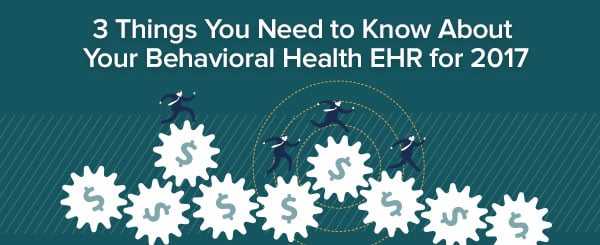3 Things You Need to Know About Your Behavioral Health EHR for 2017
by Core Solutions on February 27, 2017

Not all EHRs are flexible enough to adapt to future changes. If your organization is still functioning on first-generation EHR technology, you will likely miss out on the capabilities you’ll need to handle the challenges of 2017 and beyond. A “Goldilocks” principle of sorts can be applied to two typical EHR Vendor scenarios: either they are too big to care about how future complexities will affect your specific organizational needs, or too small to tackle them. The benefits of a true EHR partner and a second generation EHR Platform are endless, but there are three big things your vendor should be able to address for you to consider it “just right” for the year ahead.
1. Your revenue cycle will be turned upside down. A value-based payments (VBP) system is quickly becoming the preferred way of managing and delivering care for many organizations. Optimizing fee-for-service billing systems as well as newer fee-for-value capabilities requires a great deal of flexibility from your EHR. These are entirely separate ways of gathering data and executing and monitoring billing operations. A flexible EHR would need to establish a centralized revenue cycle to contain data and simplify all the processes involved. You need to know whether your EHR is capable of operating on both fronts, or until transition to the VBP framework is completed.
2 The true cost of your first-generation EHR system could put you in a bad Return on Investment (ROI) position. Calculate your EHR’s added value by determining whether your current EHR:
- Helps you reach the industry standard billing collection rate of >95%
- Enables real productivity and eliminates unnecessary overhead
- Avoids unexpected costs such as billing rejections, expensive system customizations, etc.
Consider your clients’ ROI as well by confirming that your EHR ultimately improves the client experience throughout all interactions. An EHR should successfully provide enterprise scheduling, seamless service and delivery processes and client access to ensure the quality of your organizational outcomes.
3. Meeting the data and reporting needs of your state and payer constituents is the new normal. Newer and more complex regulations have laid out incentives and payment plans that require enhanced and frequent reporting. This calls for a second-generation EHR Platform that has the flexibility to adapt to incoming changes and ease the workflows associated with them. Be aware of how your EHR product will help you pull the reports necessary for the following programs:
- Merit-Based Incentive Payment System (MIPS)
- Physician Quality Reporting System (PQRS)
- Value Modifier (VM or Value-based Payment Modifier)
- Medicare EHR incentive program
- Alternative Payment Models (APMs)
Payer relationships, primary care integration, well-educated consumers and more will all affect and further complicate the relationship your BH organization has with its EHR platform. After coming to terms with the above realities, agencies must first directly address areas of potential gaps and conflict between your organization’s processes, your EHR system, and your specific needs in order to be best prepared for 2017 and be sure that your EHR Platform is “Just Right.”
- April 2024 (3)
- March 2024 (4)
- February 2024 (1)
- October 2023 (3)
- September 2023 (3)
- August 2023 (2)
- June 2023 (2)
- May 2023 (3)
- April 2023 (4)
- March 2023 (2)
- November 2022 (3)
- October 2022 (1)
- September 2022 (1)
- August 2022 (3)
- July 2022 (1)
- June 2022 (1)
- January 2022 (2)
- December 2021 (1)
- October 2021 (2)
- September 2021 (2)
- August 2021 (2)
- July 2021 (5)
- June 2021 (5)
- March 2021 (2)
- January 2020 (3)
- November 2019 (3)
- October 2019 (2)
- July 2019 (1)
- June 2019 (1)
- May 2019 (1)
- April 2019 (3)
- October 2018 (1)
- September 2018 (1)
- August 2018 (1)
- July 2018 (1)
- June 2018 (1)
- May 2018 (2)
- April 2018 (1)
- March 2018 (1)
- December 2017 (1)
- October 2017 (2)
- September 2017 (1)
- June 2017 (2)
- May 2017 (2)
- April 2017 (1)
- February 2017 (2)
- January 2017 (3)
- November 2016 (2)
- October 2016 (3)
- September 2016 (2)
- August 2016 (1)
- July 2016 (2)
- June 2016 (1)
- May 2016 (3)
- April 2016 (2)
- March 2016 (2)
- February 2016 (2)
- January 2016 (3)
- December 2015 (2)
- November 2015 (4)
- October 2015 (3)
- September 2015 (4)
- August 2015 (1)

